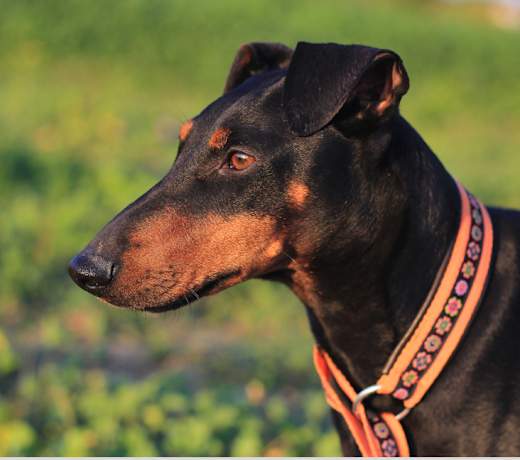Patterdale Terriers stop growing in height and reach their full adult size around 12 to 14 months of age. However, they might continue to fill out and gain muscle mass until they are about 18 months to two years old.
Patterdale Terrier
Breed Type: Terrier
Common nicknames: Black Fell Terrier, Fell Terrier, Patterdale. Pattie
Coat: Smooth, rough, wiry
Hypoallergenic: No, they will likely trigger allergies.
Temperament: Alert, active, loyal, affectionate
Life expectancy: 10-12 years
Color & patterns:

The Patterdale Terrier is an excellent choice for those seeking an active pup. With their compact size and sleek coats, they are as adorable as they are bursting with energy and tenacity. Patterdale Terriers are known for their intelligence and determination, making them excellent working dogs and companions for active individuals or families. They have a strong prey drive and thrive on mental and physical stimulation.
Patterdale Terrier characteristics
Learn about about Patterdale Terrier basics like their fur colors, shedding levels, how much grooming they need, and other Patterdale Terrier facts.
Average height
10-15 inches (25.4-38.1cm)
Average weight
10-17 pounds (4.5-7.7 kg)
Average lifespan
10-12 years
Exercise needs
Grooming needs
Full-grown size
Good with cats
Good with kids
Training aptitude
What colors do Patterdale Terriers come in?
Patterdale Terriers come in a variety of colors, including black, red, liver/chocolate, grizzle, black and tan, and bronze. Some Patterdale Terriers have white markings on the chest and feet.
How big do Patterdale Terriers get?
Patterdale Terriers are small but sturdy dogs. They are 10 to 15 inches tall at the shoulder and weigh between 10 and 17 pounds on average.
Do Patterdale Terriers shed?
Yes, Patterdale Terriers shed, but their shedding is generally considered moderate. They have a short, dense coat that can either be smooth or rough. They don’t shed as much as some longer-haired breeds, but they still lose hair, especially during seasonal changes. Brushing once or twice a week can help manage their shedding and keep their coat healthy.
Patterdale Terrier temperament
Learn about about the Patterdale Terrier temperament and how well they fit into your lifestyle, home environment, and family.
Are Patterdale Terriers good with kids?
Yes, Patterdale Terriers are good with kids who are gentle and respectful of dogs. The Patterdale’s boundless energy, enthusiastic attitude about life, and hardy, robust spirit make them fantastic companions to the energy of children.
Always supervise interactions between any dog and children to keep them both safe. With proper training and supervision, Patterdale Terriers can make loving and playful companions for children. Teaching children how to properly approach and handle dogs is crucial to ensure positive experiences for both the dog and the child, as is teaching dogs how to interact gently with children.
Are Patterdale Terriers good with cats?
No, Patterdale Terriers are not good with cats in general, although some might be able to live peacefully with cats with careful management. Patterdales have a strong prey drive, which can lead them to chase smaller animals, including cats. This drive might be more pronounced in some individuals. With proper training and socialization, many Patterdales can learn to respect boundaries and adapt to living with cats.
Are Patterdale Terriers good with other dogs?
Patterdale Terriers can get along with other dogs, especially if they are socialized with other dogs from a young age. They are playful and often enjoy the company of other dogs they have been raised with or have had positive experiences with. Some Patterdales can be territorial, which might lead to aggression or guarding behavior toward other dogs, especially if they feel their space is encroached upon.
Are Patterdale Terriers good house dogs?
Yes, Patterdale Terriers are good house dogs, but they do have specific needs that should be considered. With plenty of exercise and proper training, Patterdale Terriers can adapt well to living in a house or apartment. They thrive in homes where they receive attention, activity, and mental stimulation.
Do Patterdale terriers bark a lot?
Yes, Patterdale Terriers bark a lot and tend to be quite vocal. They are naturally alert and might bark to signal the presence of strangers or unusual activity. They might also bark when excited, especially during playtime or when anticipating a walk. If Patterdale Terriers don’t get enough exercise or mental stimulation, they might bark out of boredom or frustration. Consistent training and providing them with sufficient physical and mental activities can help manage their barking behavior.
Are Patterdale Terriers good family dogs?
Yes, Patterdale Terriers are good family dogs, especially if the family is active and willing to invest time in training and meeting their needs. They form strong bonds with family members and are known for their loyalty and affection. They are energetic and engaging dogs but have tons of energy and require lots of daily exercise and attention. They enjoy playtime and can be great companions for active families who can keep up with their energy levels.
Are Patterdale Terriers easy to train?
Patterdale Terriers are moderately easy to train. Patterdales are smart and quick learners, which can make training more straightforward. They are eager to please and respond well to positive reinforcement techniques, such as treats and praise. They are easier to train than most other terriers since they are less willful than many terrier breeds.
However, Patterdale Terriers can be somewhat independent or stubborn, which requires extra patience and persistence from the trainer. Their strong prey drive might sometimes distract them during training, especially when there are small animals or interesting scents around. However, keep in mind that training any dog takes substantial time and effort, regardless of breed.
Are Patterdale Terriers smart?
Yes, Patterdale Terriers are smart dogs. They display good problem-solving abilities, especially when it comes to hunting or exploring their environment, and they can adapt to various tasks and environments. Patterdales can learn commands and new tricks relatively quickly. Their intelligence makes them trainable, though they might exhibit independent or stubborn behaviors that require patient and consistent training.
Are Patterdale Terriers friendly?
Patterdale Terriers are typically friendly and affectionate dogs who enjoy the company of their families and can warm up to new people over time. They tend to be very loyal and form strong bonds with their pet parents, often seeking out attention and companionship.
Although they can be friendly, Patterdales also have an independent streak that can be mistaken for aloofness. They might be reserved or cautious around strangers, which can sometimes come off as standoffish until they get to know the person.
Patterdale Terrier history
Learn about where the Patterdale Terrier came from.
How long do Patterdale Terriers live?
Patterdale Terriers live around 12 to 15 years on average, though some might live longer with proper care.
Where are Patterdale Terriers from?
Patterdale Terriers originate from Northern England, specifically the Lake District and the village of Patterdale in Cumbria. They were developed in the 20th century by hunters who needed a small, sturdy, and fearless dog to help control fox populations and other vermin in the rugged, rocky terrain of the region.
Is a Fell Terrier the same as a Patterdale Terrier?
A Fell Terrier is not exactly the same as a Patterdale Terrier, though the terms are closely related and often used interchangeably. A Fell Terrier refers to a broader category of working terriers from the fell (hilly) regions of Northern England. The term “Fell Terrier” isn’t limited to a single breed but includes several types of terriers with similar characteristics, such as being small, agile, and courageous.
The Patterdale Terrier is a specific type of Fell Terrier, originating from the village of Patterdale in Cumbria. While the Patterdale is a distinct breed, it is part of the broader Fell Terrier category. The Patterdale Terrier is a type of Fell Terrier, but not all Fell Terriers are Patterdales. Fell Terriers can include a variety of other working terrier types from the same region.
What two dogs make a Patterdale Terrier?
The Patterdale Terrier is a purebred dog, but it is descended from a type of working terrier known as Fell Terriers, particularly smooth-coated, black Fell Terriers.
Patterdale Terrier health
Learn about about the Patterdale Terrier health outlook and what diseases they may be prone to at various stages of their life.
Do Patterdale Terriers have health issues?
Patterdale Terriers are generally robust and healthy dogs, but like all breeds, they can be prone to certain health issues. Some common health concerns for Patterdales include:
Hip dysplasia: A genetic condition where the hip joint doesn’t fit into the hip socket properly, which can lead to arthritis or pain.
Patellar luxation: A condition where the kneecap dislocates or moves out of its normal position, which can cause lameness or discomfort.
Cranial cruciate disease: The cranial cruciate ligament is an important stabilizer in the knee joint. Cranial cruciate ruptures cause joint instability and are the most common cause of hind leg lameness in dogs. Surgery is recommended to prevent the tear from progressing to more severe joint disease.
Intervertebral disc disease: Intervertebral disc disease causes a bulge or rupture in the discs between the vertebrae. When that happens, it can cause pain, nerve damage, and paralysis.
Hypothyroidism: This is a thyroid malfunction that results in low hormone production and could cause obesity, low energy, and a brittle coat.
Eye issues: Patterdale Terriers are prone to some eye conditions, such as cataracts or progressive retinal atrophy (PRA), a degenerative disease that causes early-onset vision loss.
Allergies: Patterdales can develop allergies, which might cause skin irritation or digestive issues.
Are Patterdale Terriers hypoallergenic?
No, Patterdale Terriers are not hypoallergenic. Hypoallergenic dogs produce fewer allergens, mainly from their skin cells, saliva, or dander, but Patterdale Terriers, like most terriers, do not fall into this category. Regular grooming and bathing can help minimize shedding and reduce allergens, but they are not an ideal breed for those with dog allergies.
Popular Patterdale Terrier mixes
Patterdale Terriers are sometimes mixed with other breeds. Common breeds that are mixed with Patterdales include:
Patterbea (Patterdale Terrier + Beagle)
Chatterdale (Patterdale Terrier + Chihuahua)
Patterjack (Patterdale Terrier + Jack Russell Terrier)
Patterland (Patterdale Terrier + Lakeland Terrier)
Patterstaff (Patterdale Terrier +Staffordshire Bull Terrier)
Patterpit (Patterdale Terrier + American Pit Bull Terrier)

Find Patterdale Terrier puppies near you
Adopting a Patterdale Terrier
Learn about acquiring a Patterdale Terrier - the pros and cons of adopting versus going through a breeder, and associated costs.

Dawa
Patterdale Terrier (Fell Terrier)
Female, 2 yrs 1 mo
West Hollywood, CA
Spayed or Neutered
Shots are up-to-date

Luna
Patterdale Terrier (Fell Terrier) Chihuahua
Female, puppy
Los Angeles, CA
Not good with dogs
Good with cats
Spayed or Neutered
Shots are up-to-date

Dawa
Patterdale Terrier (Fell Terrier)
Female, 2 yrs 1 mo
West Hollywood, CA
Spayed or Neutered
Shots are up-to-date

Luna
Patterdale Terrier (Fell Terrier) Chihuahua
Female, puppy
Los Angeles, CA
Not good with dogs
Good with cats
Spayed or Neutered
Shots are up-to-date



